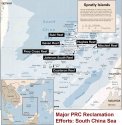Who Is the Biggest Aggressor in the South China Sea?
[Who Is the Biggest Aggressor in the South China Sea?
In the past 20 years, Vietnam has doubled its holdings in the South China Sea.
By Greg Austin
June 18, 2015
In 1996, Vietnam occupied 24 features in the Spratly Islands (source). At that time, according to the same source, China occupied nine. By 2015, according to the United States government, Vietnam occupied 48 features, and China occupied eight.
On May 13, U.S. Assistant Secretary of Defense, David Shear, said this to the Senate Foreign relations Committee: “Vietnam has 48 outposts; the Philippines, 8; China, 8; Malaysia, 5, and Taiwan, 1.”
In the past 20 years, according to the United States, China has not physically occupied additional features. By contrast, Vietnam has doubled its holdings, and much of that activity has occurred recently. The Vietnamese occupations appear to have increased from 30 to 48 in the last six years.
Shear also pointed out that as of his speech, China did not have an airfield as other claimants did. He said:
All of these same claimants have also engaged in construction activity of differing scope and degree. The types of outpost upgrades vary across claimants but broadly are comprised of land reclamation, building construction and extension, and defense emplacements. Between 2009 and 2014, Vietnam was the most active claimant in terms of both outpost upgrades and land reclamation, reclaiming approximately 60 acres. All territorial claimants, with the exception of China and Brunei, have also already built airstrips of varying sizes and functionality on disputed features in the Spratlys.
It appears China has now built an airfield and that this was already visible in April 2015, when the Daily Mail reported that “images showed a paved section of runway 505m by 53m on the northeastern side” of Fiery Cross Reef. Now media pundits are engaged in a debate about how many acres China has reclaimed, suggesting that China has been more aggressive than Vietnam because it has reclaimed more acres.
The statement by Shear in May puts additional critical light on the suggestion of some in the United States that China is not only making “preposterous” claims but is being the most aggressive actor in the territorial disputes (see: “Intelligence Check: Just How ‘Preposterous’ Are China’s South China Sea Activities?”). Shear specifically said that between 2009 and 2014, Vietnam had been the most active. This helps us understand what Chinese military leaders mean when they say China has shown “great restraint.”]

